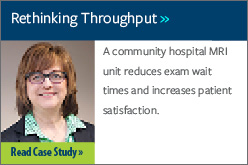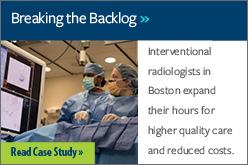Editor’s note: The following article first appeared in the JACR: “Optimizing Modality Operations,” Boland, Giles W. et al. Journal of the American College of Radiology, volume 11, issue 7, 654–655. Additional content is provided here with the goal of connecting the concepts with ACR tools and resources.
 A successful imaging outcome for a patient requires that each step of the workflow, from examination request to timely communication of actionable information, be optimized in order to deliver maximal quality, safety, and patient satisfaction. This series uses the concept of the imaging value chain to understand how this can best be achieved. The prior article discussed imaging protocol optimization, which has a direct impact on the successful management of modality workflow and operations, the focus of this article.
A successful imaging outcome for a patient requires that each step of the workflow, from examination request to timely communication of actionable information, be optimized in order to deliver maximal quality, safety, and patient satisfaction. This series uses the concept of the imaging value chain to understand how this can best be achieved. The prior article discussed imaging protocol optimization, which has a direct impact on the successful management of modality workflow and operations, the focus of this article.
From the institutional perspective, optimization of modality operations is complex given the mix of patients in different locations with different acuity of illnesses being serviced by complex equipment run by a variety of operators. Given the expensive nature of imaging technology, a goal of the operations should be the provision of examinations of uniform high quality irrespective of equipment, operator, or time of an examination. As much as possible, therefore, standardization of equipment, protocols, staffing, and examination performance should be goals of the operation.
Many factors contribute to optimal modality operations, but an incorrect or inadequate imaging protocol (including those that are unnecessarily complex) will undermine any attempt to process patients in a safe and customer-focused environment. Given the continued high demand for cross-sectional imaging (despite health care reform), departments are continuously being challenged to operate their modalities as efficiently as possible to maximize patient access. Once an imaging examination has been ordered (assuming it is appropriate), it behooves the organization to complete it as soon as possible so that both referring physician and patient can decide what further diagnostic or therapeutic steps are necessary. Operations, particularly for high-fixed cost cross-sectional modalities, must therefore be streamlined to facilitate maximal patient throughput, while delivering quality and safety. Some may believe these are mutually exclusive goals, but in truth they are synergistic when performance is optimized. For instance, unnecessary lengthy and cumbersome protocols often result in image degradation due to patient motion.
Achieving this will require an understanding of the nature of the business, “just-in-time” delivery of patients, human resource allocation, IT, and scheduling across multiple modalities [1, 2]. Each will be discussed in turn.
Providers must first recognize that inpatient and outpatient operations are effectively different businesses, each catering to different customers with different expectations. Mixing these patients into a single workflow is invariably disruptive, compromising quality, safety, and patient satisfaction. An urgent inpatient MRI or CT request, for example, will likely displace a previously scheduled outpatient. And, notwithstanding such delays, outpatients are uneasy when interspersed between severely ill patients in what they expected to be a dedicated, customer-friendly outpatient environment. Ideally, therefore, inpatients and outpatients should be triaged to different scanners accordingly. In the hospital setting, the operations can be further optimized by colocating expensive CT and MR scanners adjacent to each other (rather than in disparate parts of the hospital) so that any patient delays on one unit can be mitigated by scanning patients on an adjacent unit.
 Some institutions have gone a step further by allocating entire schedules (or scheduling blocks) on some modalities dedicated to specific disease categories (eg, musculoskeletal or neurologic imaging). Mixing patients with different diseases on the same scanner will inevitably challenge technologists to deliver the desired imaging protocols consistently and accurately. Conversely, equipment dedicated to a specific specialty permits technologists to become far more familiar with the set protocols while understanding the needs and concerns of that particular patient cohort.
Some institutions have gone a step further by allocating entire schedules (or scheduling blocks) on some modalities dedicated to specific disease categories (eg, musculoskeletal or neurologic imaging). Mixing patients with different diseases on the same scanner will inevitably challenge technologists to deliver the desired imaging protocols consistently and accurately. Conversely, equipment dedicated to a specific specialty permits technologists to become far more familiar with the set protocols while understanding the needs and concerns of that particular patient cohort.
The dual strategies of differentiating inpatient from outpatient scanners and triaging patients toward machines dedicated to particular subspecialties will, realistically, be achievable only in larger organizations. Organizations with fewer machines will inevitably require technologists to navigate through the multitude of different protocols on the same scanner, so advanced technologist training is usually needed to deliver (as best can be achieved) safety, quality, and patient satisfaction. Other support services will be particularly important under this scenario, thus allowing technologists to focus on prompt patient scanning. On the inpatient side, “just-in-time” patient delivery to scanners will usually necessitate dedicated imaging department transporters who, being part of the imaging care team, fully understand their role in coordinating the handoff of the patient from the ward to timely delivery at the imaging suite. A disorganized patient transportation process frequently translates into scanning bottlenecks. Given the cost of the imaging equipment and the imperative for rapid inpatient scanning, organizations would do well to ensure adequate patient transporter staffing. The cost can be easily justified by viewing radiology as part of the continuum of care for inpatients and that imaging is often needed before a patient is discharged from the hospital. On the outpatient side, sufficient reception staffing is necessary to manage the complex demands from patients checking in at the facility, the numerous telephone calls from stakeholders seeking patient add-ons, way finding, or other general information. Many of these functions are better managed with other back-office support personnel.
Two further tactics to maximize technologist productivity are (1) minimizing (or eliminating) tasks immaterial to technologists’ core activities by delegating them to support personnel, thus allowing technologists to focus on fast and safe patient scanning, and (2) titrating the number of technologists at any given time to the natural variation of patient demand during the day. During peak demand, it may be prudent to employ up to 3 technologists (who can now perform the multiple tasks in parallel), whereas during the less busy times of the day, 2 technologists may suffice [3]. Appropriately increased technologist staffing can therefore be a source of modality efficiency, quality, safety, and patient satisfaction, rather than a cost. To further promote rapid patient access, the modality operating hours should be extended to match patient demand, particularly into the evening and on weekends. Experienced outpatient operators are well aware that MRI demand often persists late into the evening, and most scanners can accommodate a 12- to 16-hour operation on weekend days. Through the combination of extended operational hours and technologist staffing optimization, many organizations can improve patient access 2-fold or more [3]. Radiology operations managers and physicians should also routinely review imaging protocols, volumes by machine, location, and time of day so as to modify scheduling slots and staffing to accommodate variable demand. Time-motion studies may be useful in this regard [4].
 Underpinning these efficiency measures will require robust information system integration. Ideally, electronic health records and radiology information systems will inform radiology staff members early as to whether there are absolute or relative contraindications for requested imaging procedures. Such alerts can facilitate appropriate patient preparation before arrival at the imaging suite and may prevent the patient from arriving at all, minimizing or avoiding unnecessary modality downtime and patient inconvenience. Once within the imaging suite, technologists can ideally organize their workflow from scanner consoles with patient work lists automatically uploaded from the radiology information system and the acquired images transmitted seamlessly into the PACS. Further appropriate use of IT systems facilitates training, education, and quality control measures between the radiologist and technologist. Given the intense pressure for rapid patient throughput and reporting, radiologist quality feedback (both positive and negative) is frequently overlooked. Application tools can now be placed onto PACS workstations and linked to specific patient studies so that radiologists can input feedback on quality to the relevant technologists and managers.
Underpinning these efficiency measures will require robust information system integration. Ideally, electronic health records and radiology information systems will inform radiology staff members early as to whether there are absolute or relative contraindications for requested imaging procedures. Such alerts can facilitate appropriate patient preparation before arrival at the imaging suite and may prevent the patient from arriving at all, minimizing or avoiding unnecessary modality downtime and patient inconvenience. Once within the imaging suite, technologists can ideally organize their workflow from scanner consoles with patient work lists automatically uploaded from the radiology information system and the acquired images transmitted seamlessly into the PACS. Further appropriate use of IT systems facilitates training, education, and quality control measures between the radiologist and technologist. Given the intense pressure for rapid patient throughput and reporting, radiologist quality feedback (both positive and negative) is frequently overlooked. Application tools can now be placed onto PACS workstations and linked to specific patient studies so that radiologists can input feedback on quality to the relevant technologists and managers.
In summary, rapid patient access to cross-sectional imaging remains a prime prerogative for all radiology departments. Organizations must understand the nature of their business and modulate their workflow accordingly using appropriate human and IT resources to manage high–fixed cost assets. These relatively small upfront incremental costs can translate rapidly into reductions in operational waste and costs, while yielding higher quality, safety, and patient satisfaction.
Value Chain Series
- Delivery of Appropriateness, Quality, Safety, Efficiency and Patient Satisfaction
- Appropriateness, Scheduling, and Patient Preparation
- Protocol Design and Optimization
- Optimizing Modality Operations
- Actionable Reporting
- Communication of Actionable Information
- Business Intelligence, Data Mining, and Future Trends
References
- Mayo-Smith, W.W. Administering a CT division. Radiology. 2002; 222: 319–326
- Boland, G.W.L. Diagnostic imaging centers for hospitals: a different business proposition for outpatient radiology. J Am Coll Radiol. 2007; 4: 581–583
- Boland, G.W.L. Enhancing CT productivity: strategies in increasing productivity. AJR Am J Roentgenol. 2008; 191: 3–10
- Mayo-Smith, W.W., Rhea, J.T., Smith, W.J., Cobb, C.M., Gareen, I.F., and Dorfman, G.S. Comparison of costs using transportable versus fixed platform CT scanners. Radiology. 2003; 226: 63–68